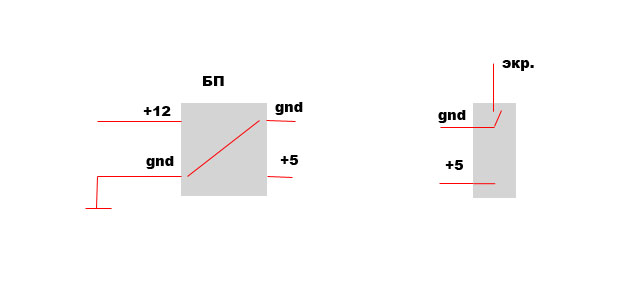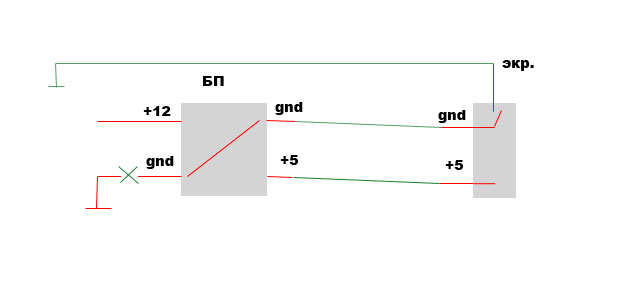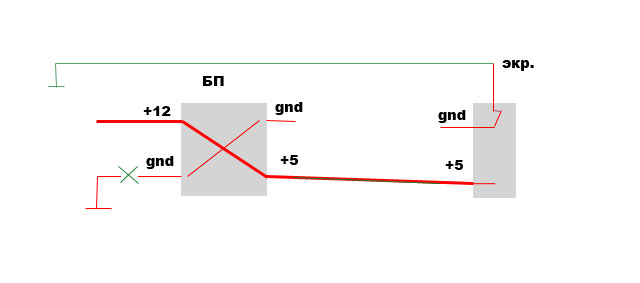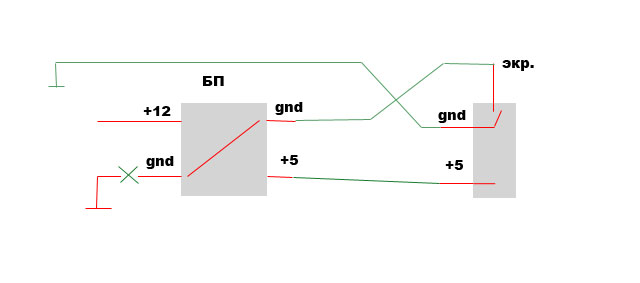Simple "intelligent" autoload for mobile device
I want to share with habrovchanami construction of a simple car charger, which is able to completely de-energize itself when disconnecting the connector from a charged smartphone / tablet. Charging consumption in standby mode is zero. If it is interesting to you how to make it elementary with your own hands without resorting to the help of electronic active components, I ask under cat. You will need the usual Chinese car charger, a USB cable, a soldering iron and a pair of hands.
I found out that the power on the cigarette lighter in my car does not disappear when the ignition is turned off. As it turned out, many cars suffer from such a “trouble”. I don’t know why, but this is a fact. At first I wanted to modify the cigarette lighter itself, but removing the connector, I saw that plus it is fed with a thick wire. I had an idea to apply plus from the ACC bus, however, I remembered that in addition to telephone charging, I also connected a pump for pumping wheels, which has serious consumption. Smoking in my car was forbidden long time ago (I have not smoked for more than 3 years), but nevertheless I wanted to keep the functionality of the factory connector.
The connector itself is installed in my car strictly horizontally and it is very convenient to include charging combined with the holder in it. I collected such a thing myself, elementarily gluing the charging case at an angle of 90 degrees to the holder. I will not talk about it here, because There is essentially nothing to talk about, but the essence of the project is not this: taking out this charge with the holder each time you leave the car is quite expensive and inconvenient, and leaving it in the cigarette lighter has the risk of a discharged battery (I don’t use this machine every day a week or two can stand in the garage). And if you think philosophically, why throw out energy to power some electronic components when nobody needs it?
')
What we have ready-made solutions to save energy? As it turned out, not so much. All factory charges, in addition to everything, are equipped with an LED that also consumes energy. True, Nokia has since some time released network charging, which is declared as “energy saving”, i.e. they just go into a certain economy mode when the charging is disconnected from the phone, but, firstly, they are network charges, and secondly, they still have a certain current consumption in standby mode.
My task was to create a charge that would not consume anything at all when disconnecting its “ward”. Making the ideal charge of the future when every milliampere can be valuable. How to do it? The logic suggests that you cannot use active elements here: if at least some part of the circuit is in standby mode and under current, it will consume energy. So you need to use either the contacts or somehow the relay, and when the phone is turned off, the relay coil should be de-energized.
In general, such solutions, of course, already exist and are as old as the world, but they usually use a separate pair of contacts to track the presence of a connector in the socket. Remember, in the old music centers, when you connect headphones to the mini-jack, the speakers were turned off. Obviously, there are no such contacts in the phones, but it is even more so at the charging connector. Now we are talking about the standard MicroUSB connector, which is used today for charging almost all modern gadgets. At first, in my head there was some kind of banal idea about a current sensor that should be included in series with the phone, but I did not understand how to implement it.
And suddenly a thought struck me. The microUSB connector, as we know, has ground (negative contact), as well as a metal case, which is inserted into the phone. In the USB cable, the case is used to connect the screen necessary to ensure the frequency characteristics of the USB 2.0 cable and screening, but it is not used in charging. Meanwhile, inside the phone, the screen is always connected to the “ground”. So what can we do? Right! Track the closure of the connector housing with a minus (gnd) connector. If there is a circuit, then the connector is inserted into the phone!
No sooner said than done. To begin with, I disassembled the charging connector and saw that the connector case in it is really not connected anywhere. With the help of a soldering flux and 5 minutes of patience, I managed to tack the connector case (as usual, he did not want to solder). Obviously, we need another cable, because in charge, the thrifty Chinese put in the cable, of course, only two wires, and we will need three to implement our idea. It was decided to use a USB cable with 4 wires. The cable was Chinese and braided in it (which, in principle, did not surprise me), was not at all.
Then I laid all the components on the table in front of me and began to think how to implement this idea. To collect thoughts in a heap, made a drawing.

At the left - / (), on the right - a phone connector. The contacts schematically show how when inserting the connector into the phone, the screen and the gnd contact close. Charging is the most standard on the basis of the pulse converter MC34063A. It is shown that inside the charging ground at the input is connected to the ground at the output, because There is no galvanic isolation in this charge. Of course, we need to commute the earth at the entrance of the landfill, since at the output, it is already “switched” by disconnecting the connector. We want to de-energize the charging itself. This means that we will land on it not at the entrance, but through the phone connector (since, as I said, inside the charging they are connected together). Factory ground wire must be broken. And it should look like this:

Looking at the drawing, everything seems to be working out correctly. When the phone connector is not connected, the conditional contacts (in the drawing on the right) are open, as it were, and the circuit is completely de-energized. When the connector is inserted, the earth circuit is closed through the phone and the charger begins to feed, charging the phone. Everything seems to be nice and beautiful ... But here my many years of experience as an electronics developer worked. I thought: what is the order in which the contacts in the telephone connector are connected? It is completely obvious that the connector body closes first; He first touches the phone when connected. You can easily verify this by looking at the connector. And in what order are the remaining contacts closed? First gnd or +5? This is not known! And it may differ depending on the implementation of a particular connector, wear, contact length, etc., etc. Well, if the + 5c contact closes earlier than the Gnd, our gadget will have an unpleasant surprise. We look at the scheme ... guessed?

That's right, “honest” 12 volts from the cigarette lighter get on our device through the circuit of an unpowered power supply !!! Of course, this voltage will pass through the converter circuit, but even the potential of 12v at a small current can be quite enough to kill our smartphone.
How to be? Everything is very simple. We need to contact GND, coming from the machine, always connected first. And which GND contact is always connected first? Correctly, the case of the connector! So all we have to do is swap the two lands on the connector. Like this:

What do we have in this case? Suppose that earlier in the phone connector connected contact + 5V. It's okay, the screen has also already connected (it, as we remember, is connected first), but the second contact gnd is not yet connected, hence the circuit is completely de-energized. And if earlier, on the contrary, the contact gnd of the phone connector is connected? Nothing terrible too: Z / U is powered, because the screen is already connected, and the phone is not, because + 5V is still open.
As a result, in the last figure we have a fully working scheme of car charger, which does not consume a single milliampere of precious energy when the phone is turned off and can remain inserted into the cigarette lighter socket for a year! The final chord, do not forget to connect the D + and D- contacts in the microUSB connector so that the smartphone understands that it is charging, not the USB cable, and is charged with a maximum current.
This device I have collected and successfully operated in the car to charge the smartphone HTC Nexus One.
If you suddenly want to repeat my design, please be careful and do not confuse the two lands on the phone connector!
:-)
I found out that the power on the cigarette lighter in my car does not disappear when the ignition is turned off. As it turned out, many cars suffer from such a “trouble”. I don’t know why, but this is a fact. At first I wanted to modify the cigarette lighter itself, but removing the connector, I saw that plus it is fed with a thick wire. I had an idea to apply plus from the ACC bus, however, I remembered that in addition to telephone charging, I also connected a pump for pumping wheels, which has serious consumption. Smoking in my car was forbidden long time ago (I have not smoked for more than 3 years), but nevertheless I wanted to keep the functionality of the factory connector.
The connector itself is installed in my car strictly horizontally and it is very convenient to include charging combined with the holder in it. I collected such a thing myself, elementarily gluing the charging case at an angle of 90 degrees to the holder. I will not talk about it here, because There is essentially nothing to talk about, but the essence of the project is not this: taking out this charge with the holder each time you leave the car is quite expensive and inconvenient, and leaving it in the cigarette lighter has the risk of a discharged battery (I don’t use this machine every day a week or two can stand in the garage). And if you think philosophically, why throw out energy to power some electronic components when nobody needs it?
')
What we have ready-made solutions to save energy? As it turned out, not so much. All factory charges, in addition to everything, are equipped with an LED that also consumes energy. True, Nokia has since some time released network charging, which is declared as “energy saving”, i.e. they just go into a certain economy mode when the charging is disconnected from the phone, but, firstly, they are network charges, and secondly, they still have a certain current consumption in standby mode.
My task was to create a charge that would not consume anything at all when disconnecting its “ward”. Making the ideal charge of the future when every milliampere can be valuable. How to do it? The logic suggests that you cannot use active elements here: if at least some part of the circuit is in standby mode and under current, it will consume energy. So you need to use either the contacts or somehow the relay, and when the phone is turned off, the relay coil should be de-energized.
In general, such solutions, of course, already exist and are as old as the world, but they usually use a separate pair of contacts to track the presence of a connector in the socket. Remember, in the old music centers, when you connect headphones to the mini-jack, the speakers were turned off. Obviously, there are no such contacts in the phones, but it is even more so at the charging connector. Now we are talking about the standard MicroUSB connector, which is used today for charging almost all modern gadgets. At first, in my head there was some kind of banal idea about a current sensor that should be included in series with the phone, but I did not understand how to implement it.
And suddenly a thought struck me. The microUSB connector, as we know, has ground (negative contact), as well as a metal case, which is inserted into the phone. In the USB cable, the case is used to connect the screen necessary to ensure the frequency characteristics of the USB 2.0 cable and screening, but it is not used in charging. Meanwhile, inside the phone, the screen is always connected to the “ground”. So what can we do? Right! Track the closure of the connector housing with a minus (gnd) connector. If there is a circuit, then the connector is inserted into the phone!
No sooner said than done. To begin with, I disassembled the charging connector and saw that the connector case in it is really not connected anywhere. With the help of a soldering flux and 5 minutes of patience, I managed to tack the connector case (as usual, he did not want to solder). Obviously, we need another cable, because in charge, the thrifty Chinese put in the cable, of course, only two wires, and we will need three to implement our idea. It was decided to use a USB cable with 4 wires. The cable was Chinese and braided in it (which, in principle, did not surprise me), was not at all.
Then I laid all the components on the table in front of me and began to think how to implement this idea. To collect thoughts in a heap, made a drawing.

At the left - / (), on the right - a phone connector. The contacts schematically show how when inserting the connector into the phone, the screen and the gnd contact close. Charging is the most standard on the basis of the pulse converter MC34063A. It is shown that inside the charging ground at the input is connected to the ground at the output, because There is no galvanic isolation in this charge. Of course, we need to commute the earth at the entrance of the landfill, since at the output, it is already “switched” by disconnecting the connector. We want to de-energize the charging itself. This means that we will land on it not at the entrance, but through the phone connector (since, as I said, inside the charging they are connected together). Factory ground wire must be broken. And it should look like this:

Looking at the drawing, everything seems to be working out correctly. When the phone connector is not connected, the conditional contacts (in the drawing on the right) are open, as it were, and the circuit is completely de-energized. When the connector is inserted, the earth circuit is closed through the phone and the charger begins to feed, charging the phone. Everything seems to be nice and beautiful ... But here my many years of experience as an electronics developer worked. I thought: what is the order in which the contacts in the telephone connector are connected? It is completely obvious that the connector body closes first; He first touches the phone when connected. You can easily verify this by looking at the connector. And in what order are the remaining contacts closed? First gnd or +5? This is not known! And it may differ depending on the implementation of a particular connector, wear, contact length, etc., etc. Well, if the + 5c contact closes earlier than the Gnd, our gadget will have an unpleasant surprise. We look at the scheme ... guessed?

That's right, “honest” 12 volts from the cigarette lighter get on our device through the circuit of an unpowered power supply !!! Of course, this voltage will pass through the converter circuit, but even the potential of 12v at a small current can be quite enough to kill our smartphone.
How to be? Everything is very simple. We need to contact GND, coming from the machine, always connected first. And which GND contact is always connected first? Correctly, the case of the connector! So all we have to do is swap the two lands on the connector. Like this:

What do we have in this case? Suppose that earlier in the phone connector connected contact + 5V. It's okay, the screen has also already connected (it, as we remember, is connected first), but the second contact gnd is not yet connected, hence the circuit is completely de-energized. And if earlier, on the contrary, the contact gnd of the phone connector is connected? Nothing terrible too: Z / U is powered, because the screen is already connected, and the phone is not, because + 5V is still open.
As a result, in the last figure we have a fully working scheme of car charger, which does not consume a single milliampere of precious energy when the phone is turned off and can remain inserted into the cigarette lighter socket for a year! The final chord, do not forget to connect the D + and D- contacts in the microUSB connector so that the smartphone understands that it is charging, not the USB cable, and is charged with a maximum current.
This device I have collected and successfully operated in the car to charge the smartphone HTC Nexus One.
If you suddenly want to repeat my design, please be careful and do not confuse the two lands on the phone connector!
:-)
Source: https://habr.com/ru/post/183078/
All Articles